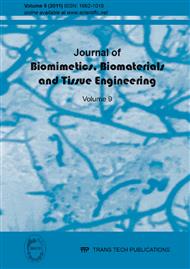p.1
p.17
p.25
p.37
p.47
p.57
p.69
p.81
p.93
A Kangaroo Spine Lumbar Motion Segment Model: Biomechanical Analysis of a Novel In Situ Curing Nucleus Replacement Device
Abstract:
This in vitro study compared the effects of nucleotomy alone, with nucleotomy then implantation with a novel nucleus replacement device (D3 device) in a single segment kangaroo spine model. This study utilised dynamic biaxial biomechanical testing of intact, nucleotomy and nucleus replacement implant conditions to evaluate the kinematic behaviour of the single segment kangaroo lumbar spine. Studies have examined the biomechanical efficacy of invasive treatments such as Total Disc Replacement and Intervertebral Fusion for the treatment of chronic low back pain, however no studies to date have investigated the biomechanical effects of a novel elastomeric compressive load sharing nucleus replacement device. Kangaroo lumbar spine motion segments with all musculature, ligamentous tissue and posterior elements removed, were tested in intact state prior to undergoing nucleotomy or nucleotomy then nucleus implantation using the D3 device. All specimens were tested in flexion-extension and lateral-bending; Range of motion (ROM), Neutral Zone (NZ), Hysteresis (H), and Elastic Stiffness (ES) were evaluated. Nucleotomised motion segments demonstrated a 30% to 90% increase in ROM, NZ, H, but not ES for all Flexion-Extension testing conditions and in Lateral Bending test conditions when compared to intact state. Implantation of the nucleus replacement device demonstrated no significant difference when compared to intact state except for H during Lateral Bending testing conditions when compared to the intact state. Therefore, there was a significant increase in ROM, NZ, and H after Nucleotomy during Flexion-Extension motions and an increase in ROM alone during lateral bending motions in the single segment kangaroo spine model. These changes return to that of the intact state with the placement of a novel nucleus replacement device. Our data suggest that the D3 device tested can restore the kinematic changes of a degenerated disc represented by the nucleotomised single motion segment.
Info:
Periodical:
Pages:
25-35
Citation:
Online since:
January 2011
Authors:
Price:
Сopyright:
© 2011 Trans Tech Publications Ltd. All Rights Reserved
Share:
Citation:


